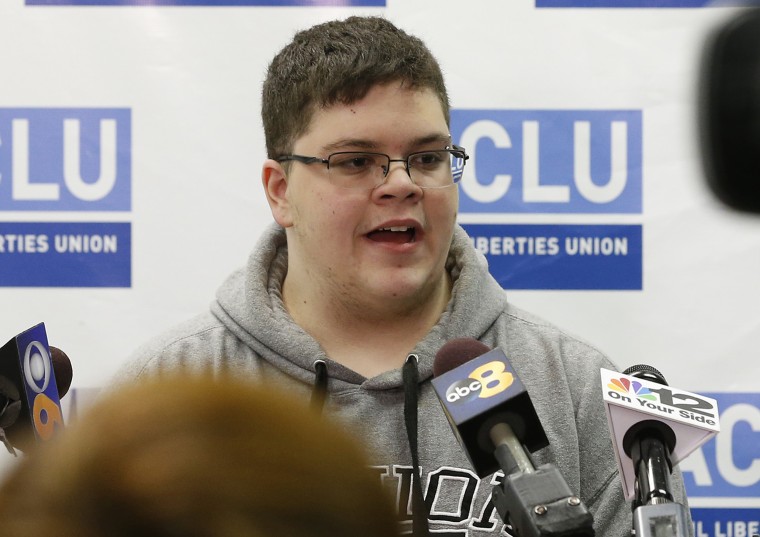The Impact Of Discriminatory Military Policies: A Transgender Sergeant's Story

Table of Contents
The US military, once a symbol of strength and equality, has a complex and troubling history regarding transgender service members. Discriminatory military policies have had a profound and lasting impact on the lives of countless individuals. This article shares the personal story of a transgender sergeant, illuminating the devastating consequences of these policies and advocating for a more inclusive future. We will explore the personal impact of these policies, the broader systemic issues of military discrimination, and the path towards a more inclusive military for transgender service members and other LGBTQ+ personnel.
The Personal Impact of Discriminatory Policies
The lived experience of transgender individuals within the military under discriminatory policies paints a stark picture of hardship and injustice. The challenges faced extend far beyond simple inconvenience; they represent a systemic failure to recognize the value and contributions of transgender service members.
Challenges Faced Before Policy Changes:
Before recent policy shifts, transgender service members faced immense obstacles:
- Constant Harassment and Discrimination: Many experienced daily harassment and discrimination from fellow service members, superiors, and even medical personnel. This ranged from verbal abuse and subtle exclusion to physical threats and violence. The lack of institutional support often left them feeling vulnerable and alone.
- Difficulty Accessing Appropriate Healthcare: Accessing gender-affirming care, including hormone therapy and surgeries, was often incredibly difficult, if not impossible. This lack of access directly impacted their physical and mental well-being. The existing healthcare system was not equipped to handle the specific needs of transgender individuals, often leading to further stigmatization and distress.
- Fear of Outing and Potential Discharge: The constant fear of being outed and subsequently discharged from service created a climate of secrecy and anxiety. This fear prevented many from seeking necessary support or living authentically. The threat of losing their career and livelihood created a significant barrier to seeking help.
- Impact on Mental Health: The cumulative effect of these challenges resulted in significantly increased rates of anxiety, depression, and PTSD among transgender service members. The constant stress of navigating a discriminatory environment took a severe toll on their mental health. Many suffered in silence due to fear of retribution.
- Specific Discriminatory Incidents: One transgender sergeant, for example, recounted being repeatedly misgendered by superiors, denied promotion opportunities despite exemplary performance, and subjected to verbal abuse in the barracks. These incidents highlight the pervasive nature of the discrimination faced.
The Emotional Toll of Living Authentically While Serving:
Serving one's country while suppressing one's true identity is an immense emotional burden. For transgender service members, this internal conflict added another layer of difficulty:
- The Struggle Between Duty and Identity: Many felt a deep conflict between their duty to serve and their desire to live authentically. They had to constantly choose between their career and their well-being.
- Pressure to Conform: The constant pressure to conform to gender stereotypes and hide their true selves created a sense of isolation and alienation. They felt like they had to constantly perform a role, rather than being themselves.
- Impact on Self-Esteem: The lack of support and the pervasive stigma significantly impacted their self-esteem and sense of worth. Feeling constantly judged and marginalized eroded their confidence.
- Difficulty Building Relationships: Building trust and meaningful relationships with colleagues became difficult, as they often couldn't be their true selves. The fear of being discovered and rejected created barriers to connection.
- Impact on Family Life: The stress of serving in a hostile environment often spilled over into their personal lives, affecting their relationships with family and friends. Many felt unable to be open about their identities with loved ones for fear of judgment or rejection.
The Broader Systemic Issues of Military Discrimination
The experiences of individual transgender service members are part of a larger picture of systemic discrimination within the military.
The History of Exclusion and its Legacy:
Discriminatory policies targeting transgender individuals have a long history:
- Timeline of Discriminatory Policies: A timeline reveals a pattern of exclusion, from outright bans on transgender service to policies that effectively forced individuals to hide their identities under threat of discharge.
- Legal Battles: Countless legal battles have been fought to challenge these discriminatory policies, highlighting the ongoing struggle for equality.
- "Don't Ask, Don't Tell": The "Don't Ask, Don't Tell" policy, while ostensibly aimed at homosexual service members, also disproportionately affected transgender individuals. Its repeal, while a step forward, did not immediately erase the legacy of harm.
- Societal Impact: The impact of these policies extends beyond the individuals directly affected, contributing to broader societal misconceptions and prejudice against transgender people.
The Cost of Exclusion:
The consequences of excluding transgender individuals from the military are significant:
- Loss of Skilled Service Members: Discriminatory policies have led to the loss of talented and dedicated service members, weakening the military’s capabilities.
- Financial Burden: The financial cost of litigation, the loss of skilled personnel, and the negative impact on morale represent a significant burden on taxpayers.
- Damage to Reputation and Morale: The military's reputation and internal morale suffer when it excludes talented individuals based on prejudice.
- Missed Opportunities for Diversity and Inclusion: A diverse and inclusive military is a stronger military. By excluding transgender people, the military misses out on a rich source of talent and perspective.
The Path Towards a More Inclusive Military
While progress has been made, significant challenges remain in creating a truly inclusive military environment.
Policy Changes and Their Impact:
Recent policy changes allowing transgender individuals to serve openly have had both positive and negative impacts:
- Analysis of Current Policies: A critical analysis of current policies is necessary to assess their effectiveness in creating an inclusive environment.
- Positive and Negative Effects: The positive effects include increased visibility and acceptance, but negative effects remain due to bureaucratic hurdles, a lack of consistent implementation, and continued discrimination.
- Areas for Improvement: Areas requiring improvement include access to gender-affirming care, protection against harassment and discrimination, and streamlined processes for transitioning within the military.
Advocacy and Activism:
Continued advocacy and activism are crucial to achieving full military inclusion:
- Role of LGBTQ+ Organizations: LGBTQ+ organizations and their allies play a vital role in pushing for legislative changes and providing support to transgender service members.
- Importance of Advocacy and Legislation: Continued legislative action and advocacy are essential to protect the rights of transgender service members and to dismantle remaining barriers.
- Power of Personal Stories: Sharing personal stories, like that of the transgender sergeant featured in this article, is crucial in changing hearts and minds and promoting understanding.
- Examples of Successful Campaigns: Highlighting successful advocacy campaigns can inspire continued action and demonstrate the power of collective effort.
Conclusion
This article, through the powerful story of a transgender sergeant, has highlighted the devastating consequences of discriminatory military policies. The personal struggles faced by transgender service members reveal the urgent need for comprehensive change, not just in policy but also in attitude and culture. The military's strength lies in its diversity; excluding transgender individuals undermines this strength and prevents the military from accessing the talent and dedication of a large segment of the population. The ongoing fight for inclusivity requires continuous effort from all stakeholders: legislators, military leadership, advocacy groups, and individual allies.
Call to Action: Let's work together to build a more inclusive and equitable military where all service members are valued and respected, regardless of their gender identity. Continue to advocate for the elimination of discriminatory military policies and support organizations fighting for transgender rights and military inclusion. Demand change, fight for a future where all can serve their country with honor and dignity. Learn more about the impact of discriminatory military policies and how you can help create lasting change for transgender service members.

Featured Posts
-
 Andor Season 2 What We Know So Far About The Release Date And Trailer
May 16, 2025
Andor Season 2 What We Know So Far About The Release Date And Trailer
May 16, 2025 -
 Knicks Narrow Escape A Look At The Overtime Loss
May 16, 2025
Knicks Narrow Escape A Look At The Overtime Loss
May 16, 2025 -
 Nba Playoffs Tatum And Brown To Play In Game 3 Holiday Sidelined
May 16, 2025
Nba Playoffs Tatum And Brown To Play In Game 3 Holiday Sidelined
May 16, 2025 -
 Almeria Y Eldense Partido En Vivo Y Estadisticas La Liga Hyper Motion
May 16, 2025
Almeria Y Eldense Partido En Vivo Y Estadisticas La Liga Hyper Motion
May 16, 2025 -
 Did The Mavericks Suffer More From Brunson Leaving Than Trading Doncic Analyzing The Impact
May 16, 2025
Did The Mavericks Suffer More From Brunson Leaving Than Trading Doncic Analyzing The Impact
May 16, 2025
